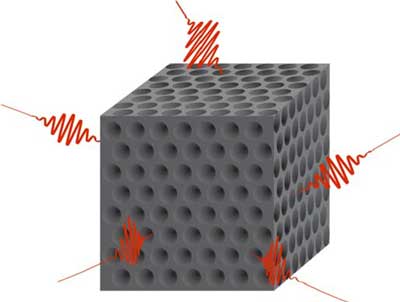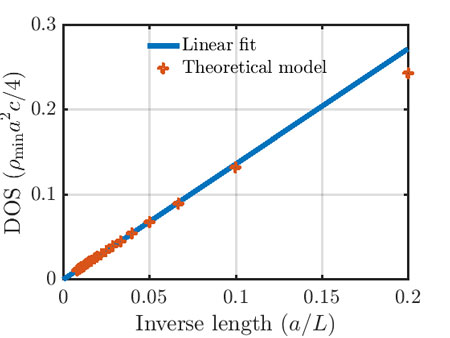| Posted: May 31, 2018 |
The straight path to absolute darkness
(Nanowerk News) Scientists at the University of Twente in the Netherlands have obtained new insights in the control of light by nanostructures. They discovered for the first time ever how the amount of omnipresent light noise depends on the size of any nanostructure, and how fast the perfect limit of zero noise is reached. Their theory yields design rules for on-chip devices that are currently being made including lasers, light emitting diodes, solar cells, and quantum computers. The Twente paper will appear in June in the world’s leading physics journal Physical Review Letters (preprint: "Finite-size scaling of the density of states in photonic band gap crystals").
|
|
Everyone knows that if one switches off all lights at night in a closed room darkness ensues. Curiously, however, the laws of quantum mechanics reveal that no space is ever dark - not even the darkest cellar or cupboard – as there exist omnipresent fluctuations of light also known as vacuum fluctuations or light noise. While invisible to the human eye, light noise is readily detected by atoms. In fact, they are perturbed by the light noise to the extent that they do not remain in their excited-energy state but quickly fall to a low-energy state, while radiating an energy quantum of light, the well-known photon. The number of photons per second emitted by the atom – in other words, the power emitted by a source – is proportional to the light noise.
|
 |
| Figure 1. Cartoon of a finite photonic crystal nanostructure in free space. The photonic crystal consists of periodic arrangements of pores in a semicon¬ductor material such as silicon (shown in grey) that are being fabricated in Twente. Light noise in the sur¬rounding free space is shown as the red wavelets. For a range of colors of light (known as photonic band gap), the light noise is forbidden from entering the crystal, thus leading to strong darkness! The question solved in Twente is: How fast is absolute darkness reached while making the nanostructure larger and larger? (Image: University of Twente)
|
|
It has been predicted that light noise can be completely eliminated in nanostructures known as photonic crystals. Hence, inside such a periodic nanostructure absolute darkness reigns, even darker than in the darkest cellar! Previous theory has it, however, that a periodic structure must be repeated indefinitely throughout the entire universe to possess this extraordinary property. Naturally, real nanostructures are finite. Therefore, inside real crystals it is not absolute dark, and an embedded excited atom does not remain excited forever. Hence, the natural question arises: how fast is absolute darkness reached by making nanostructures larger and larger?
|
|
Until now, it was known that the light noise at one position inside a real finite crystal approaches the infinite size limit exponentially. In other words, if a certain crystal has two-fold suppressed noise, a twice larger crystal has four-fold suppressed noise. In many practical cases, however, like lasers, LEDs, solar cells, we are not concerned about one atom at one place, but about many atoms at many places. Thus, engineers are rather interested in the average light noise inside a nanostructure, and how this depends on size. It is impossibly difficult to compute the average noise by computing it at many points in the crystal. Hence, a new approach was called for.
|
 |
| Figure 2. Light noise as a function of the inverse size of the nanostructure. Red data points are calculated with the new theory, for the case of 3D photonic crystal nanostructure. The solid blue line is a straight line that fits well to the data points. (Image: University of Twente)
|
|
Scientists of the University of Twente's MESA+ Institute for Nanotechnology have solved the long-standing problem (since the 1980s) by developing a theory that describes how light noise is suppressed as a function of the crystal size. The result of their sophisticated analysis is surprisingly simple – the density of light noise is inversely proportional to the linear extent of the crystal (see Figure 2), much slower than the widely anticipated exponential decrease. Prof. Ad Lagendijk points out: "It is astonishing that this straight path to absolute darkness universally applies to nanostructures not only in three dimensions, but also in two dimensions (as for periodic arrays of nanorods or nanoholes in a slab) or even in one dimension (as for periodic stacks of layers). Our discovery helps photonic engineers to design nanostructures of appropriate size to achieve a desired functionality".
|
|
A second new insight revealed by the Twente study is that light noise inside a real and finite nanostructure is essentially concentrated near the external surface. “This implies that we should place our atoms adequately away from the surface to profit from the perfect case, a favorable situation that you normally never encounter,” laughs Lagendijk. As for the applications of their discovery, Lagendijk is ebullient: “Photonic nanostructures are employed in many devices such as on-chip miniature lasers, light emitting diodes by our collaborators at Philips Lighting, or photovoltaic cells. And in the context of hotly pursued qubits: they are also affected by light noise, so placing them in a photonic nanostructure helps to improve quantum computers.”
|


